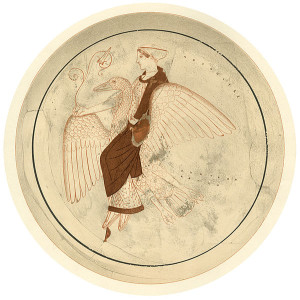
A study published earlier this year out of the State University of New York – Buffalo, finding that men are more narcissistic than women, was met with jokes and derision for being yet another academic examination of the obvious, but author Emily Grijalva responded eloquently that it is precisely those things that “everybody knows” that need to be examined. Not simply because they might not be true, although (obviously) there is a chance that they are false: establishing a fundamental fact (the what) allows us to move on to questions of why or how.
I thought of Grijalva’s words when I saw the promotion for Breaking the Mother Goose Code, about Mother Goose as a surviving form of the Mother Goddess. I believe I may have heard this idea from Z Budapest in the mid-1980s, but I don’t believe she made any claim to have researched this herself. I began showing my own students a picture of Aphrodite on her goose and calling her an early form of Mother Goose, and I don’t think it occurred to me or to anyone to examine the assumption.
In Breaking the Mother Goose Code Jeri Studebaker chronicles her effort to pin down the source of the nursery character, and on the journey with Mother Goose finds a long history of suppression of the Mother Goddess. Without delving exhaustively into the patriarchal takeover of Europe and the Christian takeover of religion, Studebaker provides the background for understanding why Mother Goose is such a powerful figure and how Christianity changed her. Studebaker gives a history of the fairytale and a synopsis of the prevalent theories for how European fairytales developed. There is a more detailed examination of the German goddess Holda than most women will be familiar with, along with some discussion about the goddesses Baba Yaga, Mari, Brigid and Aphrodite. There is some examination of theater history related to the Harlequin that appears in one of the rhymes. In addition to a history of their publication, Studebaker goes through the nursery rhymes line by line and attempts to decipher them. This involves a great deal of conjecture, but apparently this author is intrepid.
Studebaker’s intuition is on track in the avenues she explores, even when she admits that her evidence is tenuous. In some cases she seems to be unaware of information that would bolster her arguments further. I do disagree with her argument about classic fairytales created as an underground Pagan resistance movement. If anything, I think these fairytales were created as allegories against rival Christian institutions. I was going to expound on this, but it’s a rather esoteric point.
There is some great supplemental material in the appendices: a glossary, a list of fairytale codewords, a synopsis of the stories in Tales of Mother Goose, two timelines, and the full text of a Holda fairytale. The author did not neglect to provide references, a bibliography, and an index, which in this case were essential.

All in all I really liked this book (except for the pictures – did I mention that?). I hope the author will return to the subject of nursery rhymes, including Mother Goose. While the book is a respectable 300 pages there is still a lot of gold to mine here.
